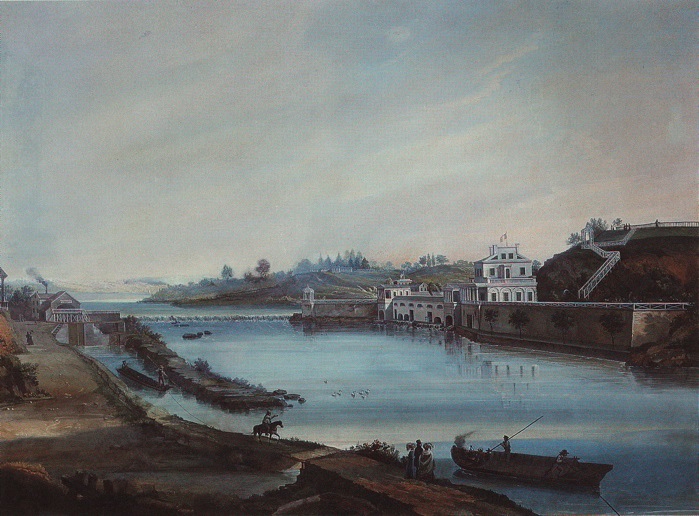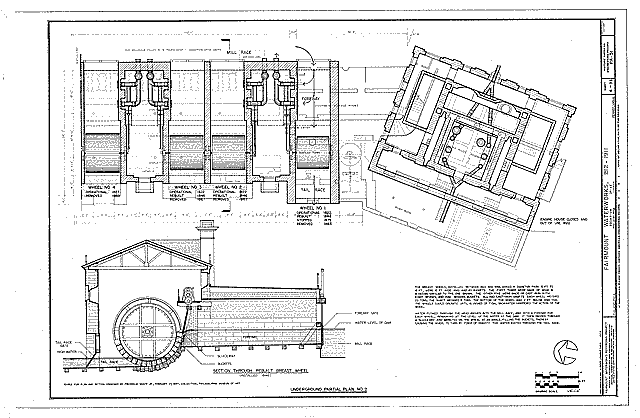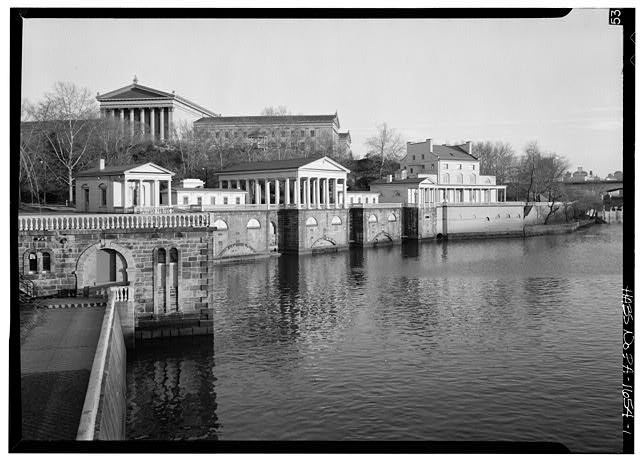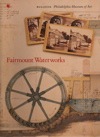
Fairmount Water Works, 1812-1815, 1819-1822, 1851, 1859-1862, 1868-1872
Aquarium Drive, Philadelphia PA
© Jane Mork Gibson,
Workshop of the
World (Oliver Evans Press, 1990).
The Fairmount Water Works is
one of the most striking examples of industrial
archeology in Philadelphia. The complex of buildings
located on the east bank of the Schuylkill River north of
the Spring Garden Bridge, represents an innovative
approach that was undertaken by the city in 1812 to
provide a municipal water supply following the
inadequacies of the earlier Centre Square system that
began operations in 1801. The buildings were constructed
or remodeled in five stages that mirror the changes in
the technology involved. 1
Charged with providing a sufficient supply of potable
water for the city, the Joint Committee on Supplying the
City with Water, known as the Watering Committee, had
been formed in 1798 and was made up of members of the
Select and Common Councils of Philadelphia. Frederick
Graff had assisted Benjamin Henry Latrobe at the Centre
Square Works and was appointed Superintendent in 1805. He
continued in this position at the Fairmount Water Works,
and is responsible for the design of most of the
buildings and the technology, utilizing portions of the
earlier system. Upon Graff's death in 1846, his son,
Frederic Graff, Jr., was appointed Superintendent,
serving until 1856, and again from 1867 to 1872.
The first stage in the development of Fairmount Water
Works employed steam engines to power the pumps, in the
same manner as in the Centre Square system, except that
two engines were housed in one building so that if one
was inoperable, the other could take on the "duty," and
the greatly feared danger of lack of water during a fire
could be avoided. The Engine House at Fairmount was
therefore designed to house two steam engines—a low
pressure Bolton & Watts style engine built by Samuel
Richards, or Foxall-Richards, at the Eagle Works in
Philadelphia and the Weymouth Forge in South Jersey, and
a high pressure Columbian noncondensing steam engine
built by Oliver Evans at the Mars Works in Philadelphia.
The low pressure engine had a steam cylinder 43-5/8 in.
diameter and a six foot stroke; the lever beam was 23 ft.
9 in. long between centers and was cast in two leaves;
the pump was double acting, 20 inches diameter, and with
a 6 foot stroke. At first it was operated at 2.5 psi, but
this was increased to 4.0 psi after the flue of the
chimney was enlarged. It took seven cords of oak wood to
raise 2,116,882 U.S. gallons to the reservoir.
2
The high pressure engine had a cylinder 20 inches in
diameter and differing records indicate both a 48 in. and
a 60 in stroke; the pump was vertical and double acting,
20 in. diameter. The engine was 100 horse power, and
pressure was at times carried at 220 psi, but this was
not considered safe. There were two explosions and three
deaths due to the primitive state of the boilers and also
possibly due to the inattentiveness of the attendants. It
took ten cords of oak wood in 20 hours to raise 100
gallons 98 feet at each stroke, at 24-3/4 strokes per
minute; the capacity was confirmed to be 3,556,401
gallons in 24 hours.
On the exterior, the Engine House resembled a federal
mansion rather than an industrial facility, and the
interior did not have the normal floor levels but was a
great open space so far as possible to accommodate the
flywheels and other parts of the two steam engines.
Construction was started in 1812 and the system was in
operation in 1815. Water was drawn from the Schuylkill
River and pumped 96 ft. to the reservoir located at the
top of the hill, where the Philadelphia Museum of Art is
presently located. The high expense of operation,
estimated at $30,858 annually for either engine, and the
need for a greater supply of water led the city to
consider alternative systems in 1819. The Committee
decided to dam the Schuylkill at Fairmount and construct
a water-power system, employing breast wheels.
The city purchased the water power rights at the Falls of
the Schuylkill from Josiah White and Joseph Gillingham in
1819 and proceeded to construct a dam across the
Schuylkill at Fairmount in conjunction with the
Schuylkill Navigation Company. The dam would create a
pond from which water for pumping and for power could be
drawn. The six-foot fall was increased by the tidal
conditions below the dam, but high tide was a hinderance
causing backwater twice a day when the wheels had to
stop. Ariel Cooley was engaged to build the dam,to
consist of a 1204 foot long crib dam from the west bank -
allowing for the canal locks there—to an earthen
mound dam built to extend 270 feet out into the river
from the east bank. 3
The millrace and
space for the mill house on the east bank were blasted
out of solid rock.

HAER
Frederick Graff designed the mill house to enclose eight
breast wheels, fifteen feet wide and sixteen or eighteen
feet in diameter. The lower section of the building was
divided into twelve apartments for eight individual
forebays and four pump chambers containing two pumps
each. Thomas Oakes was the millwright who advised on the
form of the water wheel and the mill machinery. The first
three wheels were of wood, constructed by Drury Bromley
and Thomas Oakes. The remaining five were of cast iron
with wooden buckets, and were made by Rush &
Muhlenberg (sons-in-law of Oliver Evans, deceased), Levi
Morris, and Merrick & Towne. The wheels were
installed gradually from 1822 to 1843, and the first
three were replaced in 1846 by I.P. Morris with the wood
work and breastings done by Edward Heston. The speed of
the wheels varied from 11 to 14 rpm, and capacity of the
pumps varied from 91.08 to 121.4 gallons per revolution.
The pumps were situated almost horizontally and had a 16
in. diameter, with the strokes varying from 4-1/2 to 6
feet. Additional reservoirs were added on Morris Hill
(Faire Mount) above the water works until there were four
reservoirs with a capacity of 22,031,976 gallons in 1836.
The exterior of the mill house took on neoclassical lines
with the construction of two small tempiettos at each end
as a Watering Committee Building and a Caretaker's House.
The Engine House was remodeled in 1835 after removal of
the steam engines and became a public "saloon" where
refreshments were served, and the surrounding grounds
were landscaped to become a public garden. The porch
added on the river side in 1835 gave the Engine House a
neoclassical aspect to harmonize with that of the mill
house. The Fairmount Gardens thus became the forerunner
of what was to become Fairmount Park.
The third stage in the development of Fairmount Water
Works was the introduction of a small experimental Jonval
turbine in 1851, which is still "in situ," although some
parts are missing. Room for the turbine and gear train
was created between the Engine House and the Mill House,
with the pump room located under the terrace of the
Engine House. The turbine runner was 7 feet in diameter
with 30 buckets and operated at 44 rpm. The gearing
reduced the speed to 12 rpm to power a reciprocating
force pump similar to those in use at Fairmount.
The installation was under the direction of Emile
Geyelin, who had the franchise for Jonval turbines in the
United States. The new turbine had a draft tube and
was not affected by backwater, raising 1,685,016 gallons
in 24 hours. A standpipe was erected in 1852 to
accommodate the new reservoir at Corinthian Avenue, which
was a quarter of a mile away and was at a higher
elevation than the Fairmount Reservoir.
The fourth stage was the construction of the New Mill
House alongside the Mound Dam (1859-1862). This was done
to add three larger Jonval turbines to the facility and
provide a greater supply of water for the growing city.
The Act of Consolidation in 1854 had incorporated all of
the outlying districts as part of the city. John
Birkenbine was the Chief Engineer in charge of the new
addition to Fairmount. The machinery installed was
state-of-the-art and the additional pumpage required the
construction of a distribution arch leading to the
standpipe.
A continuing need to increase the water supply led to the
fifth stage which consisted of a complete remodeling of
the Old Mill House to accommodate three more large Jonval
turbines. These were installed between 1868 and 1872
under the direction of Frederic Graff, Jr. The work
included extending the river wall in places, and
rearranging the structures on the deck so that they
appear as they are today. The classical open pavilion
added in 1872 by Frederic Graff, Jr. reflected an earlier
drawing made by his father c.1920.
Fairmount Water Works in its heyday of the 1830s and
1840s was the most well-known scene of Philadelphia, and
the increasing improvement in the surrounding grounds
made it a favorite recreation spot for Philadelphians and
visitors alike. The opportunity to observe the water
wheels, pumps, and turbines made it of special interest.
And, of course, the water flowing over the dam—if
the water was high enough—was also worth watching.
Pollution of the river became a concern as early as the
1840s but little was done about it except for penalties
which were assessed and generally ignored. It was not
until the 1890s that scientific evidence was sufficient
to compel the city to build filtration plants. When
these were completed in 1909, Fairmount Water Works was
taken "off line" except for a few customers, and the
facility was decommissioned in 1911 and turned over to
the Mayor for use as a Public Aquarium.

HAER
The industrial use of the structures had ended. The
machinery—except for the 1851 Jonval turbine,
gearing and pump—was removed by March 1912. The
reservoirs were drained and construction of the
Philadelphia Museum of Art on the site was begun in 1919.
The standpipe and distribution arch were demolished in
the 1920s. In 1975 the American Society of Civil
Engineers declared Fairmount Water Works a National
Historic Civil Engineering Landmark, in 1976 it was
designated a National Historic Landmark by the U.S.
Secretary of the Interior, and in 1977 the American
Society of Mechanical Engineers made the water works a
National Historic Mechanical Engineering Landmark.
Through a concerted effort of public and private agencies
since 1974, Fairmount Water Works is being restored as a
recreational area, with a strong emphasis on its
utilitarian past. The existing industrial archeology
includes not only the 1851 Jonval turbine, gearing and
pump in situ, but also excavated artifacts including
portions of the 1872 Jonval turbine, which had been
removed to make place for the Aquarium, and portions of
the 1851 turbine vanes and runner removed c.1930 when a
sewer line was routed through the tailrace of the
turbine.
The complex of buildings and the physical features
present an opportunity to understand the past activities
of the history of the site. An Interpretive Center
focusing on the history of Fairmount Water Works and the
value of a city water supply is planned as part of the
restoration effort. This will enable visitors to learn
what was there and how it worked.
1 For a more complete
rendering of the history than is possible here, see Jane
Mork Gibson, "The
Fairmount Waterworks," Bulletin of the Philadelphia
Museum of Art, Vol. 84, Nos. 360 and 361, Summer 1988;
also, Jane Mork Gibson, Historical Report, and Susan
Stein, Architectural Report, Historic American
Engineering Record Collection, Fairmount Water Works,
HAER PA-51, Library of Congress, Washington, D.C.
2 Measurement was by ale
gallon (282 cu. in.) until 1854 when the standard, or
wine, gallon was adopted (231 cu. in.).
3 See Workshop
of the World "Fairmount Dam" for more details.
Update May
2007 (by
Jane Mork Gibson):
When the Fairmount Water Works was decommissioned in
April of 1911, the buildings and one pumping unit were
turned over to the Mayor for use as an aquarium, which
opened in November of that year. Due to a change in the
city administration, the buildings were placed in the
charge of the Fairmount Park Commission the following
spring. All of the pumping equipment was removed except
for the small Jonval turbine in the basement of the
former Engine House, which was used to provide the water
needed for the aquarium. Although the First World War
slowed down conversion, by the 1920s the Philadelphia
Aquarium was state of the art and was one of the four
largest aquariums in the world. The Engine House was
converted for office use and the main floor served as a
Lecture Hall, where attendees could watch fish in many
small aquarium tanks that had been used in the 1893
Chicago Fair and the 1905 St. Louis Fair. New discoveries
in making large strong sheets of glass for the aquarium
tanks made it possible for visitors to watch fish
swimming at eye level, a novelty at the time. The Old
Mill House contained freshwater fish, and the New Mill
House seawater fish. At one time seals from Atlantic City
spent the winter in the forebay. After a series of
mishaps, and consistent underfunding, the Aquarium closed
its doors in December of 1962.
In the 1980s, as a result of the public interest in
Fairmount Water Works and the desire to preserve the
facility, the Old Mill House, where water wheels once
turned, was stripped of aquarium construction in the
interior, and the structure was restored as a large open
space. Water storage tanks in the basement of the Engine
House were removed. The New Mill House, which had been
converted into an Olympic swimming pool, was only
structurally repaired as necessary.
Following a careful restoration of the buildings
comprising Fairmount Water Works, in 2003 the Fairmount
Water Works Interpretive Center opened in the Old Mill
House and on the lower level of the Engine House.
Reflecting the restoration effort, the city changed the
name of the street from Aquarium Drive to Water Works
Drive. The Interpretive Center provides an opportunity to
tell the two-hundred-year history of water supply in
Philadelphia, and in its exhibits focus on how
people’s actions on the land can make a difference
to their water. The displays and interactive exhibits
cover the many concerns about preserving the quality of
the city’s water. Educational programs, which
include lab participation, inform on existing conditions,
and on what can be done to improve them. As the Delaware
River Basin’s Watershed Education Center, classes
are held for school children and lectures are open to the
general public. A short movie with digital animation
tells the story of Fairmount Water Works, illustrates how
the water once flowed through the building and how the
machinery had worked. Beside the building itself, the
only artifacts remaining are the Jonval turbine and
gearing, together with the double-acting pump installed
in 1851. The Center is open Tuesday to Saturday from 10
a.m. to 5 p.m, and on Sundays from 1 p.m. to 5 p.m.
Admission is free.
The Water Works Restaurant and Lounge, located in the
Engine House and the Caretaker’s House, opened in
July of 2006 under the aegis of Michael Karloutsos.
Previously small cafés and restaurants had operated at
the Engine House on a seasonal basis with an appreciative
clientele, but no permanent plans were made. In 1981, the
existing café closed after a fire in the building.
Subsequent efforts for a restaurant were delayed by
another fire in 2002. After these many false starts,
Philadelphia has responded enthusiastically to the
establishment of the Water Works Restaurant, contributing
to the preservation and appreciation of this site.
At the 14th Annual Preservation Award Ceremony on May 2,
2007, the Preservation Alliance of Philadelphia presented
a Grand Jury Award for the South Garden and Cliffside
Restoration. The citation is reproduced here:
Originally
designed by Frederick Graff in 1829 as a romantic
landscape, by the 1990s the South Garden, adjacent to the
Water Works, suffered from vandalism and lack of
maintenance. The Fairmount Park Commission and the Fund
for the Water Works commissioned a comprehensive Historic
Landscape Report, which, in part, determined the
“target" date for the restoration should be 1875,
by which time all the essential elements were in place.
While the setting for the restoration is a designed
landscape, the restoration’s main focus was on the
architectural and built features. The Marble
Fountain—which hadn’t operated for more than
115 years—was dismantled and reconstructed after
underground water service was reinstated. The 1848
Gothic-inspired Graff Memorial underwent extensive stone
and metal restoration and conservation, and the return of
the bust of Frederick Graff.
The elaborate cast-iron railings—largely missing by
the 1990s—along with the Cliffside Path which
connects to the Art Museum were recreated, and the path
itself was stabilized and paved. Other historic features
were also introduced, including reproduction light
fixtures, benches, and ornamental railings. Now thousands
of visitors can once again experience the South Garden as
originally conceived.
See
also:
Fairmount Water Works Interpretive
Center
Historic American Enginering Record -
Fairmount Waterworks, Aquarium
Drive
Historic American Engineering Record -
Fairmount Waterworks, East bank of Schuylkill
River
 The
Fairmount Waterworks, by Jane Mork Gibson
(Philadelphia Museum of Art, Bulletin Vol. 84,
#360-361, Summer 1998). 48 pages, well illustrated
with color and black & white plates, technical
drawings and maps, 8-1/2" x 11". Published on the
occasion of the exhibition "The
Fairmount Waterworks, 1812-1911"
(July
23-September 25, 1998), celebrating the restoration
of the waterworks.
The
Fairmount Waterworks, by Jane Mork Gibson
(Philadelphia Museum of Art, Bulletin Vol. 84,
#360-361, Summer 1998). 48 pages, well illustrated
with color and black & white plates, technical
drawings and maps, 8-1/2" x 11". Published on the
occasion of the exhibition "The
Fairmount Waterworks, 1812-1911"
(July
23-September 25, 1998), celebrating the restoration
of the waterworks.